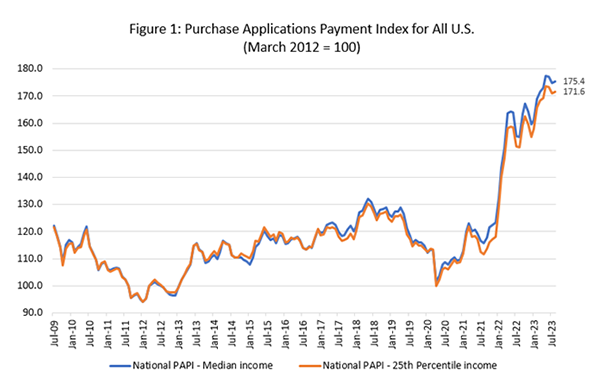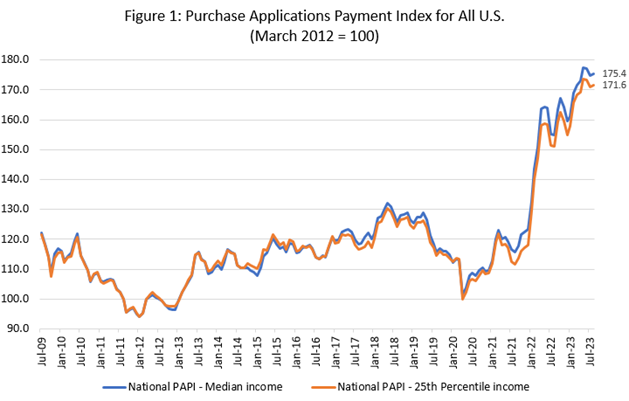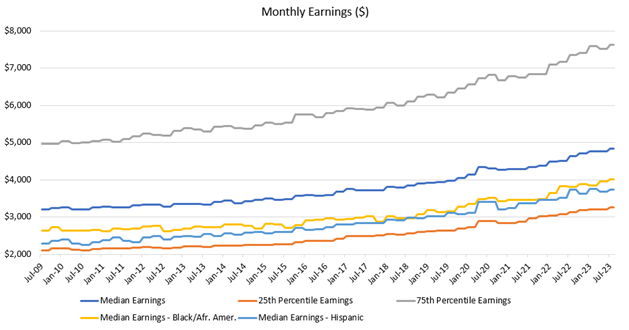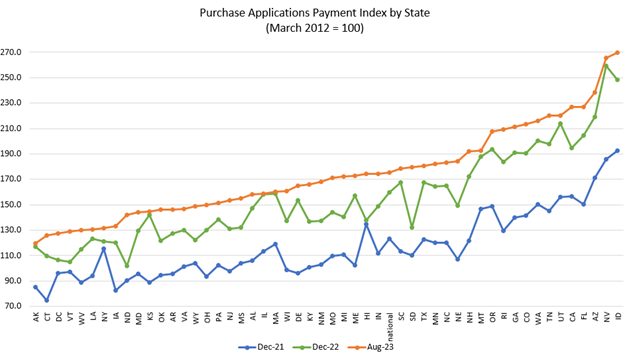
MBA: Mortgage Application Payments Increased Slightly to $2,170 in August

Homebuyer affordability declined in August with the national median payment applied for by purchase applicants increasing to $2,170 from 2,162 in July according to the Mortgage Bankers Association’s Purchase Applications Payment Index.
The Purchase Applications Payment Index measures how new monthly mortgage payments vary across time – relative to income – using data from MBA’s Weekly Applications Survey.
“Prospective homebuyers’ budgets continue to be impacted by the combination of high home prices and mortgage rates that remain higher than 7 percent,“ said Edward Seiler, MBA Associate Vice President of Housing Economics and Executive Director of the Research Institute for Housing America. “If mortgage rates shift lower in 2024 as we anticipate, the combination of rising inventory levels and lower rates should lead to stronger demand for buying a home.”
An increase in MBA’s PAPI – indicative of declining borrower affordability conditions – means that the mortgage payment to income ratio (PIR) is higher due to increasing application loan amounts, rising mortgage rates, or a decrease in earnings. A decrease in the PAPI – indicative of improving borrower affordability conditions – occurs when loan application amounts decrease, mortgage rates decrease, or earnings increase.
The national PAPI (Figure 1) increased 0.4 percent to 175.4 in August from 174.7 in July. With this increase, the PAPI is now only two points lower than its record level in May 2023. Median earnings were up 4.2 percent compared to one year ago, and while payments increased by 18.0 percent, the strong earnings growth means that the PAPI is up 13.2 percent on an annual basis. For borrowers applying for lower-payment mortgages (the 25th percentile), the national mortgage payment decreased to $1,444 in August from $1,451 in July.
The Builders’ Purchase Application Payment Index (BPAPI) showed that the median mortgage payment for purchase mortgages from MBA’s Builder Application Survey increased from $2,526 in July to $2,609 in August.
Additional Key Findings of MBA’s Purchase Applications Payment Index (PAPI) – August 2023
• The national median mortgage payment was $2,170 in August—up $8 from July. It is up $331 from one year ago, equal to an 18.0% increase.
• The national median mortgage payment for FHA loan applicants was at a record-high $1,909 in August, up from $1,854 in July and up from $1,469 in August 2022.
• The national median mortgage payment for conventional loan applicants was $2,187, down from $2,197 in July and up from $1,901 in August 2022.
• The top five states with the highest PAPI were: Idaho (269.6), Nevada (265.7), Arizona (238.6), Florida (227.2), and California (226.8).
• The top five states with the lowest PAPI were: Alaska (119.7), Connecticut, (126.0), Washington, D.C., (127.4), Vermont (128.7), and West Virginia (130.3).
• Homebuyer affordability decreased slightly for Black households, with the national PAPI increasing from 173.8 in July to 174.5 in August.
• Homebuyer affordability decreased slightly for Hispanic households, with the national PAPI increasing from 166.5 in July to 167.1 in August.
• Homebuyer affordability decreased slightly for White households, with the national PAPI increasing from 176.0 in July to 176.7 in August.



About MBA’s Purchase Applications Payment Index
The Mortgage Bankers Association’s Purchase Applications Payment Index measures how new mortgage payments vary across time relative to income. Higher index values indicate that the mortgage payment to income ratio is higher than in a month where the index is lower. Contrary to other affordability indexes that make multiple assumptions about mortgage underwriting criteria to estimate mortgage payment level, PAPI directly uses MBA’s Weekly Applications Survey data to calculate mortgage payments.
PAPI uses usual weekly earnings data from the U.S. Bureau of Labor Statistics’ Current Population Survey. Usual weekly earnings represent full-time wage and salary earnings before taxes and other deductions and include any overtime pay, commissions, or tips usually received. Note that data are not seasonally adjusted.
MBA’s Builders’ Purchase Application Payment Index uses MBA’s Builder Application Survey data to create an index that measures how new mortgage payments vary across time relative to income, with a focus exclusively on newly built single-family homes. As with PAPI, higher index values indicate that the mortgage payment to income ratio is higher than in a month where the index is lower. To create BPAPI, principal and interest payment amounts are deflated by the same earnings series as in PAPI.
The rent data series calculated for MBA’s national mortgage payment to rent ratio comes from the U.S. Census Bureau’s Housing Vacancies and Homeownership survey’s median asking rent. The HVS data is quarterly, and as such, the mortgage payment to rent ratio will be updated quarterly. Note: MPPR data is not included in this December 2022 release.
For additional information on MBA’s Purchase Applications Payment Index, click here.
